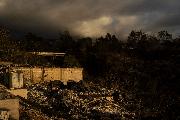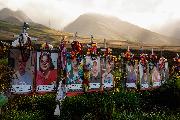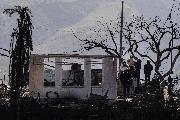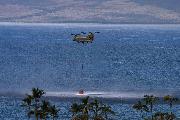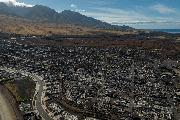
Communications breakdown left authorities in the dark and residents without alerts amid Maui fire
HONOLULU (AP) — As wildfires ripped across Maui last August, the head of the emergency management agency dragged his heels about returning to the island amid the unfolding crisis, while a broad communications breakdown left authorities in the dark and residents without emergency alerts, according to a report released Wednesday.
Communications problems were also encountered by the Hawaiian Electric Company, with officials unable to confirm that power lines were de-energized until well after flames had caused widespread damage, the report from the Hawaii Attorney General said.
It was the second of two major assessments out this week about the deadliest U.S. wildfire in a century. A report released Tuesday by the Western Fire Chiefs Association detailed the challenges facing the Maui Fire Department during the unprecedented series of blazes, including one that killed 101 people in the historic town of Lahaina.
Attorney General Anne Lopez presented the latest report at a news conference along with Steve Kerber, vice president of the Fire Safety Research Institute.
“When Attorney General Lopez contacted us, clearly we were paying a lot of attention to what was going on in Lahaina and really had the same question that she had. How is it possible that something like this could happen?” Kerber said.
The new report said that five days before the flames broke out, meteorologists warned that strengthening winds resulting from a hurricane south of Hawaii could create an extreme risk of wildfires on Aug. 8. “Confidence in the development of critical fire weather conditions this many days away is quite rare, and we believe that this warrants a heads up to you,” a National Weather Service forecaster said in an email to fire contacts Aug. 3.
The day of the fire, the wind-driven flames traveled at the “incredibly fast” rate of about a mile in 90 minutes, according to Kerber.
The Maui Emergency Management Agency had posted to Facebook on Aug. 6 about a “serious fire and damaging wind threat” due to dry conditions as Hurricane Dora passed.
The agency’s administrator, Herman Andaya, was off island at a conference on Oahu on Aug. 8 as the fires intensified. His call and text records show that he was getting updates from Gaye Gabuat, an administrative assistant. After a series of evacuations in Lahaina, Gabuat told Andaya that “multiple people look overwhelmed,” according to the report. Andaya asked if he should come home, to which Gabuat responded, “it may look okay.“
After the fire had been burning for more than five hours, Gabuat told Andaya that flames had reached Lahaina's Front Street, a tourist hot spot. Only then did Andaya respond that he had “better come home tomorrow.”
By that time multiple areas in Lahaina had been evacuated, according to a situation report by Andaya’s agency. Front Street had been closed along with the Lahaina bypass road, another key thoroughfare. In Lahaina alone, 29 utility poles were reported downed.
There was no immediate response to attempts Wednesday to reach Andaya, who resigned Aug. 18, via phone, email and social media.
Fire crews had also been trapped in the inferno, according to staffing logs included in the report. Around 4:30 p.m., two engines were destroyed. A firefighter from one of the engines had to rescue the crews using a police department SUV, according to the logs.
The report also described a breakdown in communication between police, firefighters and emergency officials after cell networks went down. Both the police and fire departments had to communicate using their handheld or car radios on closed channels that public officials and others could not listen to.
Meanwhile a stretched and limited dispatch center had single operators monitoring five or six channels at a time to keep up with what was happening.
“With no cellular communication, residents and tourists were not able to receive emergency alerts, communicate with loved ones and/or to receive incoming or outgoing calls/texts,” the report’s authors wrote.
They detailed how one police officer told other responders his daughter had been babysitting in a neighborhood that was hit by the fire. Without cell communications he had no way to check if she escaped, and it took two days before he confirmed she was OK.
The attorney general’s report is the first phase of a comprehensive assessment that includes a timeline of the 72 hours before, during and after the fire. It said investigators relied on “all known available facts” related to the fire and to the steps that local, state and federal agencies took to prepare.
It reconstructs a timeline of the Lahaina fire using social media posts, dispatch records, emergency communications and other sources.
Phase 2 of the report will focus on how Maui’s fire protection system functioned, specifically what conditions fed the inferno, attempts to stop its spread, and evacuations. The third phase will try to answer the critical question, “How do we prevent this from happening again?”
“The tragedy serves as a sobering reminder that the threat of grassland fires, wildfires, and wildfire-initiated urban conflagrations, fueled by climate change and urban encroachment into wildland areas, is a reality that must be addressed with the utmost urgency and diligence — not just in Hawaii, but around the globe,” the authors wrote.
Tuesday's report by the fire chiefs association described firefighters who carried victims piggyback over downed power lines to safety and sheltered survivors inside their engines. Another first responder drove a moped into a burning neighborhood again and again, whisking people away from danger one at a time.
Both reports described the difficulties and harrowing conditions faced by firefighters, including many resources being deployed elsewhere, structures quickly catching ablaze amid the extreme winds and downed electricity lines hampering movement. Among the challenges were poorly stocked fire engines, hydrants that lost water supply and a lack of mutual aid agreements between counties.
Many of the factors that contributed to the disaster are already known: A windstorm battering the island had downed power lines and blown off parts of rooftops, and debris blocked roads throughout Lahaina.
Hawaiian Electric has acknowledged that one of its lines fell and caused a fire in Lahaina early Aug. 8, but denies that it caused the flames that burned through the town later that day.
Cellphone and internet service was also down in the area at times, so it was difficult for some to call for help or to get information. And emergency officials did not use Hawaii’s extensive network of emergency sirens to warn residents.
Police and electricity crews tried to direct people away from roads that were partially or completely blocked by power lines. Meanwhile, people trying to flee burning neighborhoods packed the few thoroughfares in and out of town. The traffic jam left some trapped in their cars when the fire overtook them, and others who were near the ocean jumped in to escape.
The reports also highlight a vulnerability rooted in the dramatic changes Maui experienced since the arrival of Westerners and the conversion of land into pineapple and sugar plantations in the 19th century. When those closed in the late 1900s, the fallow lands became covered in invasive grasses. That and prolonged drought created a “volatile fuel bed” for fire, Tuesday's report said.
Roughly 3,000 properties were destroyed when the fire overtook Lahaina, causing more than $5.5 billion in estimated damage, according to state officials.
___
Boone reported from Boise, Idaho; Keller from Albuquerque, New Mexico; and Lauer from Philadelphia. Audrey McAvoy contributed from Honolulu.
___
This story has been updated to correct the spelling of Gaye Gabuat’s name.
© Copyright The Associated Press. All rights reserved. The information contained in this news report may not be published, broadcast or otherwise distributed without the prior written authority of The Associated Press.
